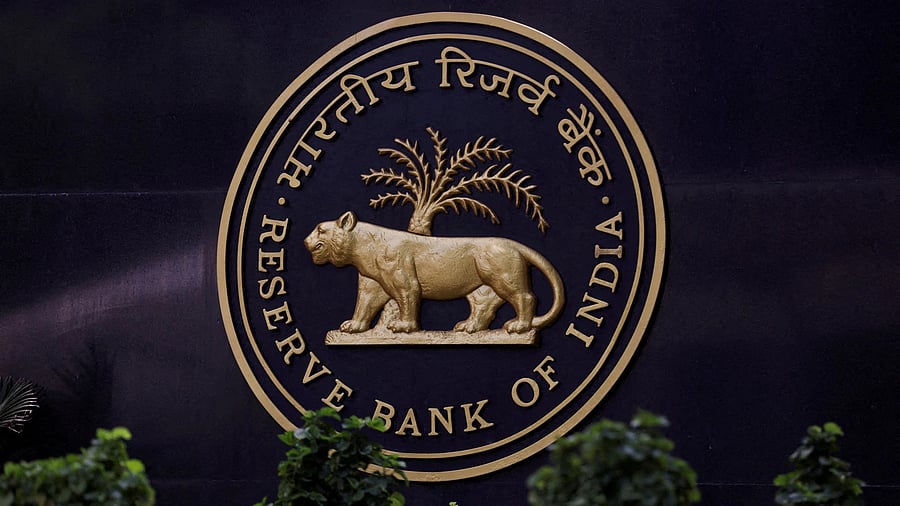
Reserve Bank of India (RBI) logo
Credit: Reuters Photo
The Reserve Bank of India’s 50-basis-point repo rate cut in June, followed by a 100-basis-point reduction in the Cash Reserve Ratio (CRR), marks the most aggressive easing cycle in half a decade. Yet despite this liquidity infusion, bond yields barely budged, and large parts of the corporate sector remain slow to respond.
While the policy move was cheered by equity markets and short-term debt traders, it did not deliver a uniform repricing across the financial system. Yields on five-year AAA-rated corporate bonds even ticked up slightly. Many firms, especially the medium, small, and micro enterprises (MSMEs), found little immediate relief in lending conditions. This mismatch between policy intent and real impact is not a short-term aberration; it reflects India’s segmented credit system.
To explain this disconnect between policy rate cuts and the actual impact, we introduce a dual-track transmission model. In this framework, we distinguish between two channels through which interest rates impact credit: i) administered track, driven by the policy rate, such as the repo, which influences bank lending through liquidity operations. ii) the market track, which works through bond markets and is captured by instruments like the 364-day treasury bill yield. This track reflects broader market forces: investor sentiment, liquidity premiums, and macroeconomic risk.
For firms seeking debt, this distinction matters. Large, listed companies with investment-grade ratings and institutional investor relationships are best positioned to benefit from market-based transmission when conditions are favourable. But even during easing cycles, bond issuance remains modest. Concerns about business opportunities, global uncertainties, fiscal risks, and a narrow investor base often discourage risk-taking, leading to muted price adjustments and low participation in corporate debt markets.
Bank-based transmission, particularly through public sector banks, is more directly linked to RBI actions. However, private banks and non-banking financial companies (NBFCs) operate with greater prudence, often constrained by asset quality challenges, balance sheet risk, and the cost of wholesale funds. Their willingness to pass on rate cuts depends on internal liquidity positions and broader credit risk appetite.
This creates a visible divide in how firms experience monetary easing. Promoter-driven, unlisted enterprises typically rely on relationship-based secured debt from banks, where access is governed equally by trust as by interest rates. For these firms, a lower repo rate does not automatically translate into more affordable credit. Lending standards, documentation norms, and working capital pressures remain the dominant constraints.
Listed and group-affiliated firms are more agile in responding to market signals. When bond yields decline, they can shift from bank loans to market funding to reduce borrowing costs. However, when bond yields remain sticky, as they have following the latest CRR cut, even these firms delay issuance, further dampening the policy effect.
The deeper issue is institutional segmentation. Factors like promoter control, listing status, group affiliation, and access to collateral are all embedded in India’s lending culture. Our financial system leans heavily on secured lending, which may protect lenders but limits the agility of borrowers. For MSMEs, this means borrowing is tethered to collateral, not to ideas, reputation, or their potential to create jobs and generate a multiplier effect.
The numbers tell the story. While bank credit to the private sector stands at 56% of GDP, banks account for nearly 70% of corporate borrowing, reflecting a persistent reliance on secured loans. Bond issuance has grown in recent years, yet fewer than 15% of rated firms use the market regularly, and fewer than 400 manufacturing companies issue bonds actively. This narrow base of bond market access limits the RBI’s ability to influence borrowing costs and disproportionately constrains MSMEs benefiting from monetary easing.
The RBI has acknowledged this problem in its June 2025 Bulletin. It noted that despite a 50-basis-point repo rate cut, the weighted average lending rate on fresh rupee loans fell by only 27 basis points. The central bank urged banks, especially private and foreign institutions, to improve the pace of transmission. Such muted adjustments highlight the deeper structural bottlenecks in the credit system, particularly for underserved and less-rated firms.
What’s the way forward?
India must tackle these asymmetries with structural reforms, not just cyclical easing. Deepening the corporate bond market is vital through simpler issuance procedures, a broader investor base, and better secondary market infrastructure. Regulatory mandates like SEBI’s rule that large borrowers raise at least 25% of their funds via bonds are directionally correct, but need stronger enforcement and ecosystem support.
Fintech lenders offer another frontier. With faster underwriting, alternative data, and lighter operating models, they can reach borrowers that traditional banks underserve. However, to make a meaningful impact, they need regulatory encouragement.
Finally, there must be a measured shift toward unsecured or reputation-based lending, particularly for MSMEs with sound governance. This doesn’t mean reckless risk-taking. But overreliance on collateral has made our credit system rigid and exclusionary.
The RBI’s policy intent is clear. However, until institutional channels and lending behaviour evolve, the impact of rate cuts will remain limited. For many firms, especially those outside the formal credit mainstream, the actual cost of borrowing has little to do with the repo rate and everything to do with where they stand in India’s fragmented financial hierarchy.
(Hiremath teaches finance & Sharma is a doctoral scholar who is researching unsecured corporate debt at IIT Kharagpur)